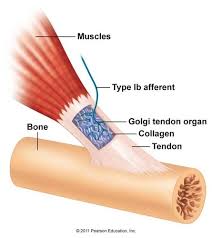 The Golgi tendon reflex (inverse stretch reflex, tendon reflex) is an inhibitory effect on the muscle resulting from the muscle tension stimulating Golgi tendon organs (GTO) of the muscle.
The Golgi tendon reflex (inverse stretch reflex, tendon reflex) is an inhibitory effect on the muscle resulting from the muscle tension stimulating Golgi tendon organs (GTO) of the muscle.
The reflex arc is a negative feedback mechanism preventing too much tension on the muscle and tendon.
When the tension is extreme, the inhibition can be so great it overcomes the excitatory effects on the muscle’s alpha motoneurons causing suddenly relaxation of muscle.
This reflex is the inverse of the stretch reflex.
GTOs’ inhibitory effects come from their reflex arcs.
The Ib sensory fibers that are sent through the dorsal root into the spinal cord to synapse on Ib inhibitory interneurons that in turn terminate directly on the motor neurons that innervate the same muscle.
The fibers also make direct excitatory synapses onto motoneurons that innervate the antagonist muscle.
This reflex pathway does not always have inhibitory effects, and under certain conditions, GTO stimulation can result in motoneuron excitation.
The GTO protects against too much tension on the muscle and tendon, the tendon reflex may help spread muscle load throughout the muscle fibers, preventing damage to isolated fibers.
The stretch reflex regulates muscle length, the tendon reflex helps regulate muscle force, helping to maintain steady levels of tension and stable joints to counteract effects that reduce muscle force, such as fatigue.
Because the Ib inhibitory interneurons receive convergent multisensory inputs and descending pathways, they may allow fine control of muscle forces, and may be better at protective functions.
The Ib fibers connect widely with the motoneurons innervating muscles working on different joints, the Golgi tendon reflex forms part of reflex networks that control movements of the whole limb.
The Golgi tendon reflex operates as a protective feedback mechanism to control the tension of an active muscle.
The Golgi tendon reflex causes relaxation before the tendon tension becomes high enough to cause damage.
When a load is placed on the muscle, the afferent neuron from the Golgi tendon organ fires into the central nervous system.
Then, secondly, the motor neuron from the spinal cord is inhibited via an IPSP (inhibitory postsynaptic potential) and the muscle relaxes.
The Ib inhibitory interneurons receive convergent descending pathways and multisensory inputs—including cutaneous receptors, muscle spindles, and joint receptors, they can provide better protection, when the joint receptors are signaling joint hyperextension or hyperflexion.
GTOs signal muscle tension continuously providing precise information about muscle force.
It allows precise control of muscle forces for fine activities, and that Ib fibers connect widely with motoneurons innervating muscles acting on different joints, which when complemented with their reflex pathways, are part of reflex networks that control movements of the whole limbs.
The inhibitory interneuron releases the neurotransmitter glycine that inhibits the α motor neuron.
As a consequence fewer nerve impulses are generated in the α motor neuron: the muscle relaxes and excess tension is relieved
The output of the Ib inhibitory interneurons are flexible because they receive inputs from golgi tendon organs, muscle spindles, cutaneous receptors, joint receptors, and different descending pathways, so that the multiple sensory/control inputs may allow fine motor activities.
In addition, stimulating GTO does not always inhibit motor neurons, because during activities such as walking, the Ib inhibitory interneurons are inhibited, and Ib excitatory interneurons stimulate the motoneurons.
The stretch reflex operates as a feedback mechanism to control muscle length by causing muscle contraction.
The tendon reflex operates as a negative feedback mechanism to control muscle tension.
The Golgi tendon reflex is a response to extensive tension on a tendon, avoiding strong muscle contractions which could tear the tendon from either the muscle or bone.
In sports, quick movements can damage the tendon before the reflex can occur.
The tendon reflex also helps spread the workload more evenly over the entire muscle by preventing muscle fibers connected with overstimulated tendon organs so that their contraction is more comparable to the contraction of the rest of the muscle.
The tendon reflex is less sensitive than the stretch reflex, but it can override the stretch reflex when tension is great.
Like the stretch reflex, the tendon reflex is ipsilateral.
Tendon organs detect and respond to changes in muscle tension that are caused by muscular contraction, but not passive stretch.
Upper motor neuron lesions which damage the descending pathways down to the spinal cord may cause increase in muscle tone.
This causes increased resistance to passive movement called spasticity, which is associated with the neurological sign, the clasp-knife response, in which the spastic muscle initially resists passive movement strongly, and then suddenly yields—like the motion of a pocketknife.
The increased initial resistance comes from the stretch reflex hyperactivity, and the sudden collapse may involve the Golgi tendon reflex.
